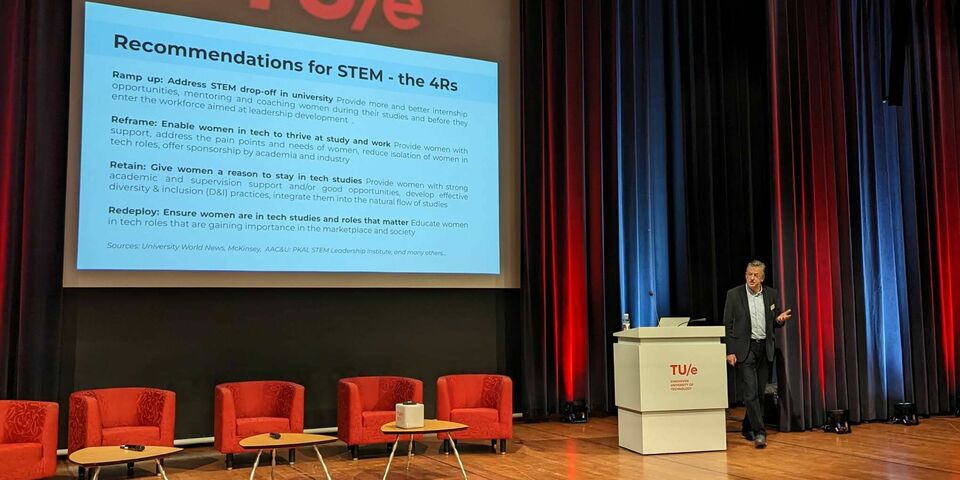“True inclusivity has a long way to go”
On Valentine's Day, TU/e staff and students came together for dinner, discussions and drinks to celebrate the International Day of Women in Science. The organizers - TINT, WISE and Beyond - named the event ‘Intercultural STEM! But how?’ and asked participants the question: how inclusive are the fields of Science, Technology, Engineering and Mathematics for internationals?
While many people are enjoying a romantic dinner at home with their significant other, the Auditorium is filling up with enthusiastic attendees who want to pay tribute to women in science tonight. Officially, the International Day of Women and Girls in Science falls on February 11, but the organizers thought Valentine’s Day would be the perfect opportunity to give women the stage. The celebration kicks off with a joint dinner; an opportunity to meet and catch up with like-minded people. Afterwards, the participants, mostly women and a few men, take their seats in the Blauwe Zaal for the main program. Everyone is welcome tonight; and that is, of course, fitting for an event that is all about inclusivity. The central question tonight is: how do we provide an inclusive STEM environment in which all internationals feel included and heard?
Cultural differences
Lecturer Vincent Merk kicks things off with a quick lecture on intercultural communication. Among other things, he explains the difference between “high-context” and “low-context” cultures. In high-context cultures, context is essential to the reception of the message; communication is indirect and implicit. “Once, during a lecture, I said: ‘I’m very hot, I think I’ll take off my jacket.’”, says Merk. “I watched in surprise as a few students stood up to open the windows. They had interpreted it as an indirect request to open the windows, while that hadn’t been my intention at all.” Low-context cultures are much more direct and tell it like it is in plain language. “It’s very simple, yes means yes and no means no.”
The Dutch clearly belong in the latter category, whereas many other cultures use “high-context”. Sometimes, those cultures clash. Merk points out what it takes to turn a multicultural environment into an intercultural one; one in which everyone feels heard and welcome. It starts with recognizing the cultural differences so they can then be respected and embraced.
“In theory, it sounds great”, responds a woman in the audience. “But how do you put that into practice? There are so many invisible structures that need to be broken down before real change can take place.” Merk agrees with the woman that it is indeed necessary to deconstruct these existing structures, but it remains unclear exactly how this is achieved.
The bridge between theory and practice
The gap between theory and practice is further bridged during the panel discussion with an assistant professor, a master’s student and a project manager from ASML. The first statement is: ‘STEM is inclusive in Eindhoven.’ The panel and audience strongly agree that there is still a long way to go in making STEM inclusive for minorities such as women and internationals. Other statements explore how participants experience work-life balance or how supported they feel by their environment. These questions bare many of the issues that are prevalent primarily among students. And many of those issues students face, like stress, high study load or financial worries, hit internationals extra hard, is one of the collective conclusions. International students pay higher tuition fees and therefore feel pressured to graduate as soon as possible.
What, how, and when you eat
The audience also shares personal experiences regarding inclusivity. Internationals, from students to PhD candidates and people working in the technology sector, express the feeling of not quite fitting in in the Netherlands. “I understand that it’s a Dutch university, but I often feel like there’s only one right way to do things. Like some kind of unwritten rule. It starts with what, how and when you eat and extends to the way meetings are held and feedback is given. It’s like everything has to be done the Dutch way. But that’s often not my way”, says a woman in the audience, herself an international.
Another woman: “I’ve been in the Netherlands for three years and I struggle quite a bit, I’m still confused about exactly how things work here. And when you're only surrounded by other internationals, it’s really hard to find your way in the Netherlands.”
Support from above
The general perception is that students find a lot of support with each other, but not enough with the university. It's almost always student initiatives that are committed to change, but we feel too little support from above. Sometimes that’s demotivating”, says one of the event’s initiators. “There’s often a missing link between the university and the students, we’re not connected”, says Elisabetta Peri, assistant professor at Electrical Engineering and one of the panelists. “That’s very unfortunate, because real change can only take place if we’re connected.”


Discussion